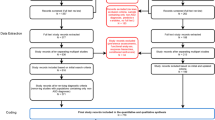Abstract
We examined two systems of assessing family interactions that are in common usage: a home based observation of free parent-child interaction and a clinic based observation of a structured mother-child problem solving discussion. Participants were 18 depressed, 27 conduct disordered and 16 comparison children and their mothers. Results indicated that: 1) these observations may yield very different data about child, and to a lesser extent, parent behavior, 2) parental affect in the clinic was related to their level of aversive behaviour in the home, 3) levels of both aversive and positive behavior for children and their mothers were correlated within each setting, 4) accuracy of diagnostic classifications made on the basis of the observational data were highest for comparison and conduct disordered children, but lowest for depressed children observed in the clinic, and 5) the inclusion of data on mothers' behavior increased classification accuracy for conduct disordered children only.
Similar content being viewed by others
References
Behrens, B. C., Sanders, M. R., & Halford, W. K. (1990). Behavioural marital therapy: An evaluation of treatment effects across high and low risk settings.Behavior Therapy, 21 423–433.
Biglan, A., Hops, H., Sherman, K., Friedman, L., Arthur J., & Osteen, V. (1985). Problem solving interactions of depressed women and their husbands.Behavior Therapy, 16 431–451.
Blechman, E. A., & McEnroe, M. J. (1985). Effective family problem solving.Child Development, 56 429437.
Dadds, M. R. (1987). Families and the origins of child behavior problems.Family Process, 26 341–356.
Dadds, M. R., Sanders, M. R., Morrison, M., & Rebgetz, M. (1992). Child depression and conduct disorder II: An analysis of family interaction patterns in the home.Journal of Abnormal Psychology, 101 505–513.
Dadds, M. R., Schwartz, S., & Sanders, M. R. (1987). Marital discord and treatment outcome in behavioral treatment of child conduct disorder.Journal of Consulting and Clinical Psychology, 55 396–403.
Daniel, A. (1983).Power, privilege and prestige. Melbourne, Australia: Longman Cheshire.
D'Zurilla, T. J., & Goldfried, M. R. (1971). Problem solving and behavior modification.Journal of Abnormal Psychology, 78 107–126.
Goodyer, J. M. (1990). Family relationships, life events and child psychopathology.Journal of Child Psychology and Psychiatry, 31 161–192.
Hahlweg, K., Reissner, L., Kohli, G., Vollmer, M., Schindler, L., & Revenstorf, D. (1984). Development and validity of new system to analyze interpersonal communication: Katagorien-system fur partnerschaftiche interaktion. In K. Hahlweg & N. S. Jacobson (Eds.),Marital interaction: Analysis and modification (pp. ). New York: Guilford Press.
Jacob, T. (1975). Family interaction in disturbed and normal families. A methodological and substantive review.Psychological Bulletin, 82 33–65.
Kazdin, A. E. (1988). The diagnosis of childhood disorders: Assessment issues and strategies.Behavioral Assessment, 10 67–94.
Kazdin, A. E. (1990). Childhood depression.Journal of Child Psychology and Psychiatry, 31 121–160.
Kazdin, A. E., French, N. H., Unis, A. S., & Esveldt-Dawson, K. C. (1983). Assessment of childhood depression correspondence of child and parent ratings.Journal of the American Academy of Child Psychiatry, 22 157–164.
Kovacs, M., & Beck, A. T. (1977). An empirical clinical approach toward a definition of childhood depression. In J. G. Schulterbrandt & A. Raskin (Eds.),Depression in children: Diagnosis, treatment and conceptual models (pp. 1–25). New York: Raven Press.
Miklowitz, D. J., Goldstein, M. J., Falloon, I. R. H., & Doane, J. A. (1984). Interactional correlates of expressed emotion in the families of schizophrenics.British Journal of Psychiatry, 144 482–487.
Patterson, G. R. (1982).Coercive family process. Eugene, Oregon: Castalia Press.
Patterson, G. R. & Reid, J. B. (1984). Social interactional processes within the family.Journal of Applied Developmental Psychology, 5 237–262.
Quay, H. C., & Peterson, D. R. (1984).Manual for the behavior problem checklist. Denver: City Publisher.
Robin, A. (1981). A controlled evaluation of problem solving communication training with parent-adolescent conflict.Behavior Therapy, 12 593–609.
Sanders, M. R., & Dadds, M. R. (1989).Depression observation schedule: An observers manual. Unpublished manuscript. University of Queensland, Brisbane.
Sanders, M. R., Dadds, M. R. & Bor, W. (1989). A contextual analysis of child oppositional and maternal aversive behaviors in conduct disordered and non-problem families.Journal of Clinical Child Psychology, 18 72–83.
Sanders, M. R., Dadds, M. R., Johnson, B., & Cash, R. (1992). Child depression and conduct disorder I: Behavioural, affective and cognitive aspects of family problem solving interactions.Journal of Abnormal Psychology, 101 495–504.
Sines J. O. (1987). Influence of the home and family environment on childhood dysfunction. In B. B. Lahey & A. E. Kazdin (Eds.),Advances in Clinical Child Psychology, Vol. 10, (pp. 1–54). New York: Plenum Press.
Strachan, A. M., Leff, J. P., Goldstein, M. J., Doane, J. A., & Burtt, C. (1986). Emotional attitudes and direct communication in the families of schizophrenics.British Journal of Psychiatry, 149 279–287.
Urbain, E. S., & Kendall, P. C. (1980). Review of social-cognitive problem-solving interventions with children.Psychological Bulletin, 88 109–143.
Author information
Authors and Affiliations
Rights and permissions
About this article
Cite this article
Dadds, M.R., Sanders, M.R. Family interaction and child psychopathology: A comparison of two observation strategies. J Child Fam Stud 1, 371–391 (1992). https://doi.org/10.1007/BF01321292
Issue Date:
DOI: https://doi.org/10.1007/BF01321292



